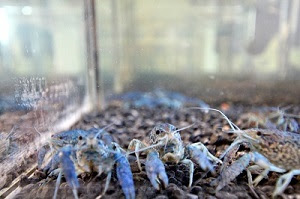Adventure
The Crawdad That Could Eat the Great Lakes

I smell gumbo. And ecological havoc.
Nobody knows better than sportsmen just how much havoc an invasive species can wreak on an ecosystem, and some recent news from the Michigan Department of Natural Resources (MDNR) may have the shiver that has invaded my spine invading yours, too. There’s a new threat to the Great Lakes that, should it ever eventuate, is going to make the zebra mussel look like a friendly tourist. It’s called the marbled crayfish, and its scientific name will give you a clue as to why this humble-looking crawdad is more than a little terrifying: Procambarus virginalis.
Did you notice that Latinate “virgin”? That’s because the marbled crayfish is capable of the arthropod version of a virgin birth. Per the MDNR: “Marbled crayfish, also known as marmorkrebs and virgin crayfish, are increasing in popularity in the aquarium trade due to their unique ability to reproduce by cloning. All known specimens are genetically identical females that can produce up to 700 eggs per reproductive cycle without the need for fertilization.” (Emphasis mine.)
We’re not really dealing with a “crawdad,” then; it’s a “crawmom” capable of asexual reproduction like a tiny Cloverfield monster.
So, the good news is that right now the Great Lakes don’t have any marbled crayfish in them. The bad news is that apparently a bunch of people who have never seen Jurassic Park thought it would be a good idea to cultivate a critter in their aquariums that’s capable of completely taking over the Great Lakes should even one get into the ecosystem. To quote Jeff Goldblum’s Dr. Ian Malcolm: “Life, uh, finds a way.”

Is it possible to eat gumbo with a vengeance?
The MDNR has just listed the marbled crayfish as a prohibited species for that reason. Species that are prohibited in Michigan cannot be possessed, introduced, imported, sold or offered for sale as a live organism, except under certain circumstances. They are asking owners of marbled crayfish to humanely dispose of any specimens in their possession and clean tanks thoroughly to assure no eggs or young remain.
If you or someone you know needs to humanely dispose of their marbled crayfish, please don’t flush them down the toilet. It doesn’t necessarily kill the animal, and it may well actually introduce it into the water system we’re trying to keep it out of. The American Veterinary Medical Association’s Guidelines for Euthanasia of Animals: 2020 Edition provides recommendations for humane disposal of aquatic invertebrates including crayfish.
“Marbled crayfish are believed to originate in the aquarium trade, and as such, they have no documented native range,” said Lucas Nathan, DNR aquatic invasive species coordinator. “In some areas where they have been released in Madagascar and several European countries, they have become established and spread rapidly.”
Native white river crayfish and calico crayfish are somewhat similar in appearance to marbled crayfish. To find information on identifying the marbled crayfish and distinguishing it from native species, visit Michigan.gov/Invasives.
-

 Adventure1 month ago
Adventure1 month agoDoes the “Big Beautiful Bill” Have a Public-Lands Wart?
-

 Adventure2 months ago
Adventure2 months agoHowling in Cuckoo: How Mexican Wolves are Fostered
-

 Adventure2 weeks ago
Adventure2 weeks agoREACTION: Trump’s Make America Beautiful Again Agenda
-

 Gear3 weeks ago
Gear3 weeks agoLet Freedom RING! Primary Arms’ Independence Day Category Sale Starts NOW
-

 Adventure4 weeks ago
Adventure4 weeks agoU.S. Bighorn Sheep Going Home to Canada
-

 Adventure1 month ago
Adventure1 month agoYour Dream Hunt Could Be a Movie & Leupold Can Help
-

 Fishing11 hours ago
Fishing11 hours agoMy Wacky Bush Brings All the Bass to the Yard






